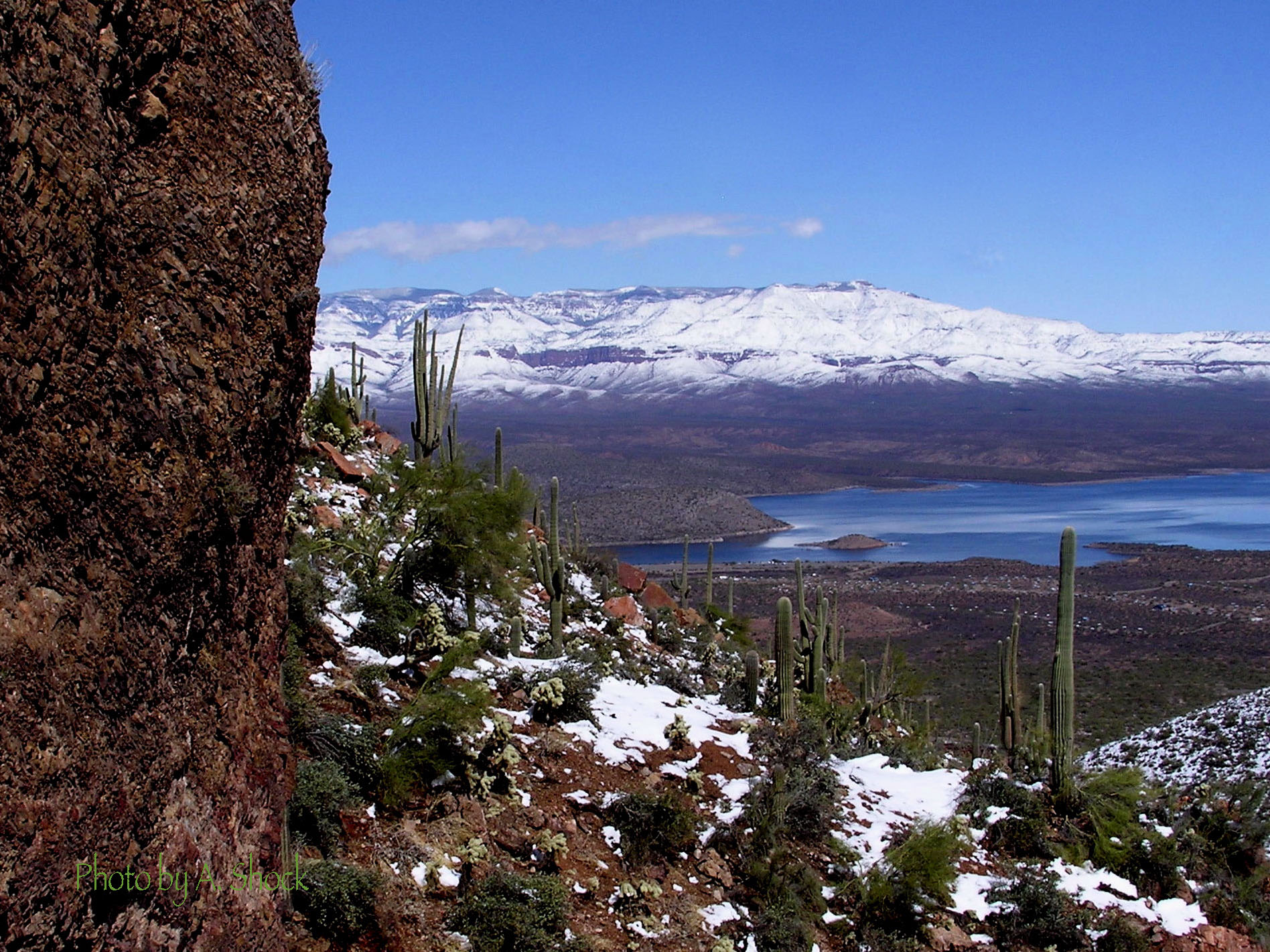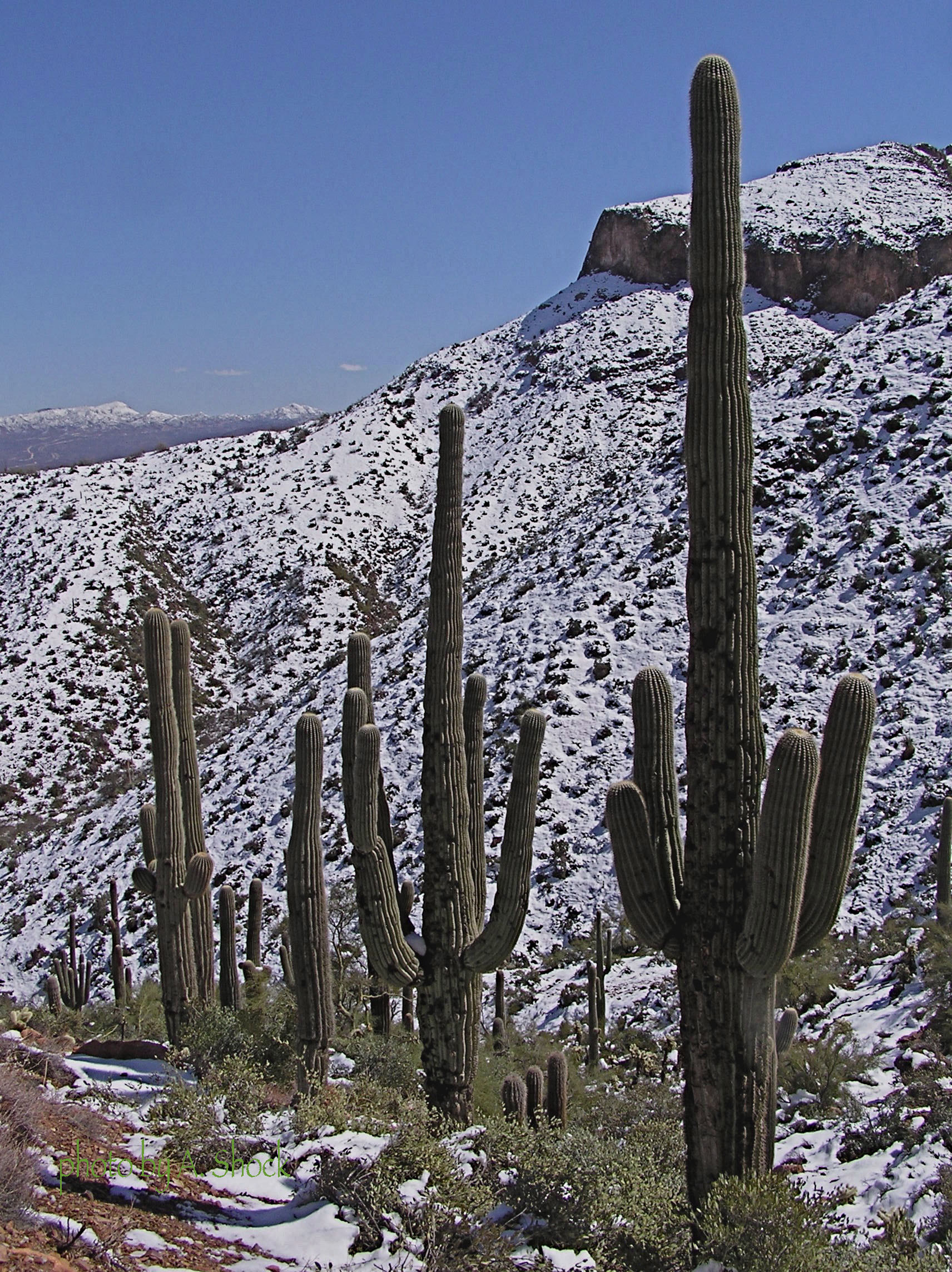Phoenix Herpetological Society
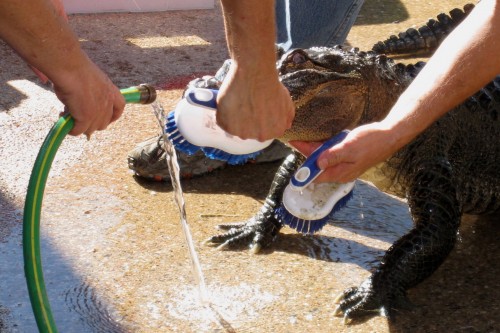 Vicki arranged for a tour of the Phoenix Herpetological Society (PHS) for some ASU colleagues. It seemed like a fascinating way to celebrate our anniversary (#24!), so E and I went. Vicki and her husband Calvin are long-time volunteers at PHS and they showed us around the facilities, which are up north off of Dynamite Rd in Scottsdale.
Vicki arranged for a tour of the Phoenix Herpetological Society (PHS) for some ASU colleagues. It seemed like a fascinating way to celebrate our anniversary (#24!), so E and I went. Vicki and her husband Calvin are long-time volunteers at PHS and they showed us around the facilities, which are up north off of Dynamite Rd in Scottsdale.
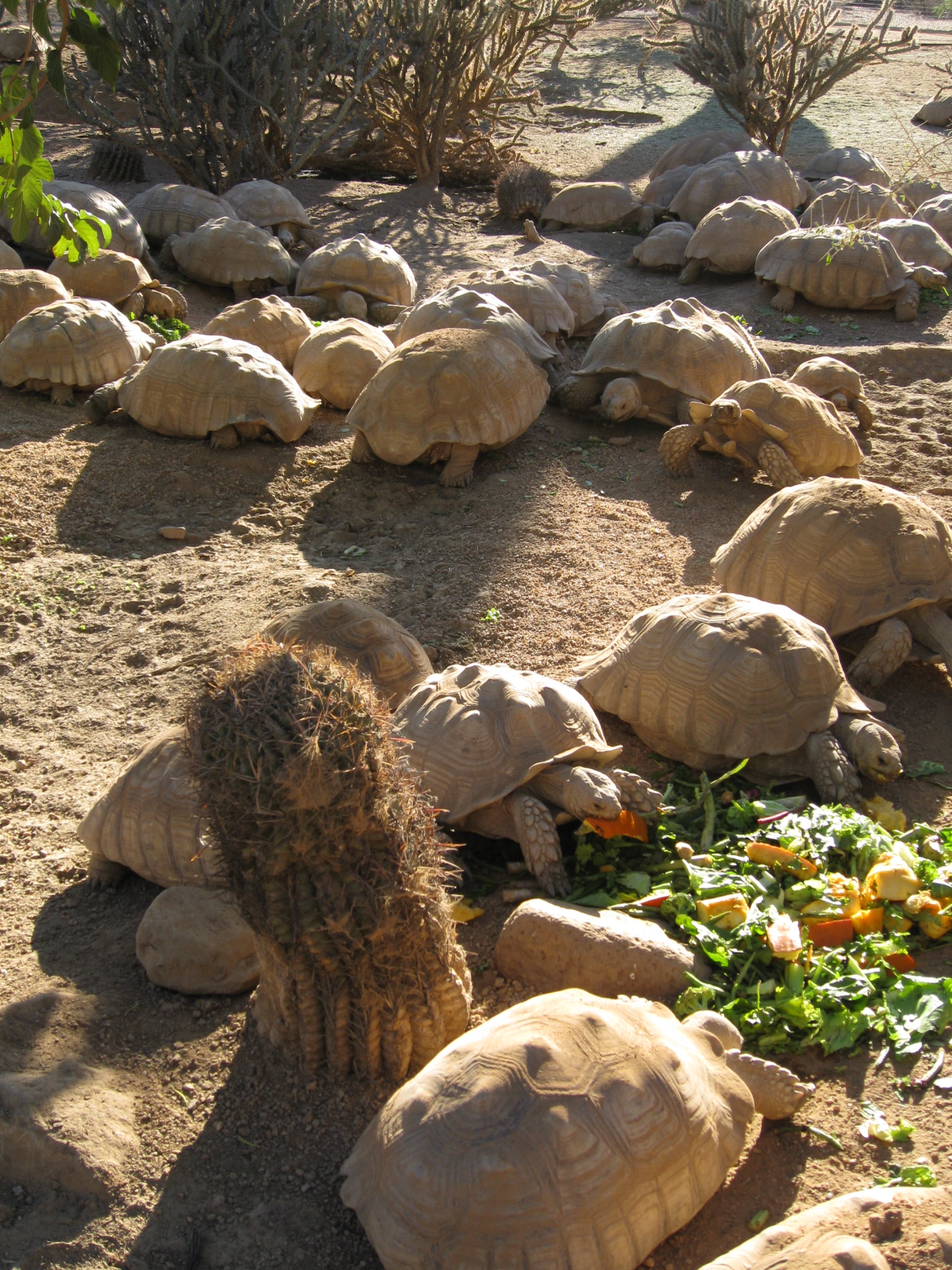 We swam a python, scrubbed an education ‘gator, and fed other alligators and a crocodile, tortoises, and iguanas of several species. By “we” I mean Vicki and Calvin, while the rest of us took pictures and asked questions. We helped a little, lobbing handfuls of produce at large lizards, poking expiration-date challenged chicken legs and donated elk shreds by the gobbet through chain link enclosures with tongs, to be snapped up by eager gator jaws. Iguanas adore grapes, and African tortoises love lettuce. A lot of lettuce. Each day crates and crates of produce donated by grocery stores go into the non-native tortoise corrals. Any idea you may have had of slow-moving giants lying about motionless is destroyed once you see a horde of tortoises trundling towards lettuce mounds.
We swam a python, scrubbed an education ‘gator, and fed other alligators and a crocodile, tortoises, and iguanas of several species. By “we” I mean Vicki and Calvin, while the rest of us took pictures and asked questions. We helped a little, lobbing handfuls of produce at large lizards, poking expiration-date challenged chicken legs and donated elk shreds by the gobbet through chain link enclosures with tongs, to be snapped up by eager gator jaws. Iguanas adore grapes, and African tortoises love lettuce. A lot of lettuce. Each day crates and crates of produce donated by grocery stores go into the non-native tortoise corrals. Any idea you may have had of slow-moving giants lying about motionless is destroyed once you see a horde of tortoises trundling towards lettuce mounds.
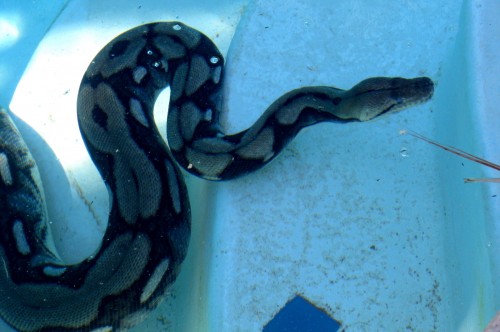 We watched Tigger, an 11 foot Reticulated Pythoness swim in the pool, while wallabies cowered at a distance. Tigger was beautiful, and unlike most snakes I’ve seen swimming who skim the surface skillfully but with purpose (why does a cottonmouth swim a creek? – to get to the other side), she was swimming for pleasure, and loved to dive down to the very bottom, where small bubbles trickled up from her iridescent scales. She looked at home in the water, like a very long, sinuous salamander. Another “Retic”, Donny, returned from an event just before we left. He was still coiled calmly in his open traveling crate, a very sturdy, well-ventilated plastic trunk on wheels, waiting for several volunteers to lift him back into his regular habitat. Donny weighs something like 350 pounds, is 18 feet long, and hasn’t maxed out in length yet.
We watched Tigger, an 11 foot Reticulated Pythoness swim in the pool, while wallabies cowered at a distance. Tigger was beautiful, and unlike most snakes I’ve seen swimming who skim the surface skillfully but with purpose (why does a cottonmouth swim a creek? – to get to the other side), she was swimming for pleasure, and loved to dive down to the very bottom, where small bubbles trickled up from her iridescent scales. She looked at home in the water, like a very long, sinuous salamander. Another “Retic”, Donny, returned from an event just before we left. He was still coiled calmly in his open traveling crate, a very sturdy, well-ventilated plastic trunk on wheels, waiting for several volunteers to lift him back into his regular habitat. Donny weighs something like 350 pounds, is 18 feet long, and hasn’t maxed out in length yet.
PHS is a place where unwanted/abandoned reptiles can find a home, where relocated rattlers live temporarily, and where herps used for education programs in schools and other venues both private and public are housed between gigs. Most of the animals we saw were either confiscated or abandoned — people leave critters in boxes on PHS’s doorstep, to avoid paying the drop-off fee. They’re homeless because of their owner’s inability or unwillingness to care for them as they grow larger.
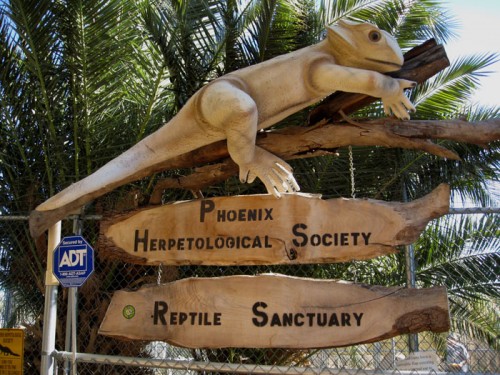 More animals are coming in to places like PHS these days because of the current economy and rising foreclosures and evictions; it’s the same at dog and cat shelters, too. We shed a few tax-deductible dollars their way before we left: PHS survives mostly on green — money or the edible sort. If you ever see your local grocer throwing away produce (or meat), tell them about Phoenix Herp Society — daily donations don’t always match the tortoises’ (and gators’) needs. And seeing all those sheltered animals drove home the need to think before buying an exotic herp to bring home: many of the PHS’s tortoises, and even some of the snakes and monitors are available for adoption to suitable homes, a really hands-on way to help out (you need to apply, be approved and pay an adoption fee). Or consider volunteering, or hiring PHS to bring critters to a home birthday party or work event for a truly unique and educational experience. Check out their website for more options.
More animals are coming in to places like PHS these days because of the current economy and rising foreclosures and evictions; it’s the same at dog and cat shelters, too. We shed a few tax-deductible dollars their way before we left: PHS survives mostly on green — money or the edible sort. If you ever see your local grocer throwing away produce (or meat), tell them about Phoenix Herp Society — daily donations don’t always match the tortoises’ (and gators’) needs. And seeing all those sheltered animals drove home the need to think before buying an exotic herp to bring home: many of the PHS’s tortoises, and even some of the snakes and monitors are available for adoption to suitable homes, a really hands-on way to help out (you need to apply, be approved and pay an adoption fee). Or consider volunteering, or hiring PHS to bring critters to a home birthday party or work event for a truly unique and educational experience. Check out their website for more options.
Museo de Antropología de Xalapa: I
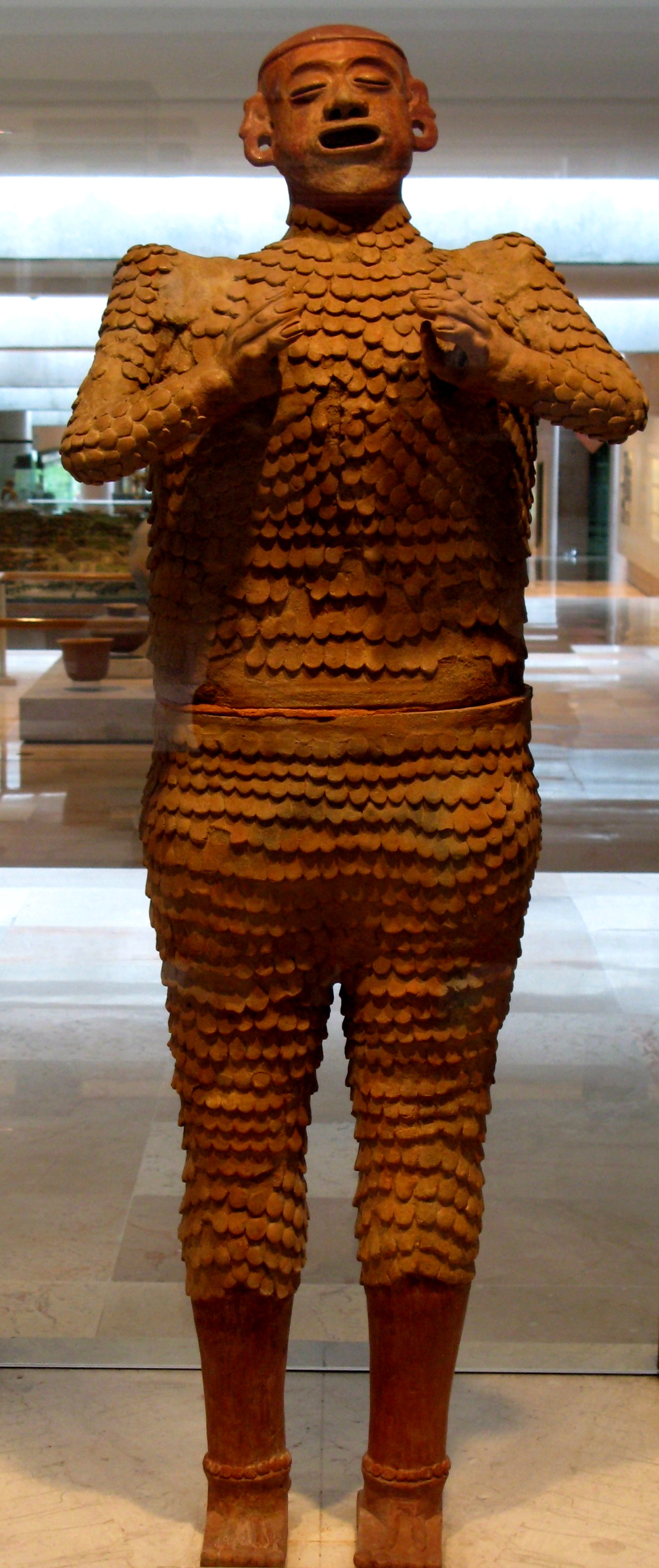 Birds weren’t the only wonderful things to be seen on a recent trip to the Mexican state of Veracruz: there was clay! The capital city of Xalapa, perched on the volcanic shoulders of the Sierra Madre Oriental, has a world-class archaeological museum, Museo de Antropología de Xalapa (MAX), stuffed full of the cultural treasures of pre-Hispanic people local to the region. For someone who works in clay, these objects are endlessly fascinating and inspirational. Here are some of my favorites. Click on any image to see a larger version. Forgive blurriness; no flash allowed, so all camera work is hand-held in low light conditions, through the glass of display cases.
Birds weren’t the only wonderful things to be seen on a recent trip to the Mexican state of Veracruz: there was clay! The capital city of Xalapa, perched on the volcanic shoulders of the Sierra Madre Oriental, has a world-class archaeological museum, Museo de Antropología de Xalapa (MAX), stuffed full of the cultural treasures of pre-Hispanic people local to the region. For someone who works in clay, these objects are endlessly fascinating and inspirational. Here are some of my favorites. Click on any image to see a larger version. Forgive blurriness; no flash allowed, so all camera work is hand-held in low light conditions, through the glass of display cases.
Surprising to me: nearly life-sized human figures in clay. I’d seen examples in stone (like the big Olmec heads, several of which are on display at MAX), or in bas-relief, but not in clay and modeled in the round. On the right, check out Xipe Totec “the Flayed One”, scary deity of death/rebirth wearing the skin of a human, flaking off him as it decays — a practice shown in Aztec sculpture actually carried out by priests, wearing the skins of sacrificed captives. This sculpture was made in 3 pieces: head, torso/arms, and pelvis/legs, and assembled after firing, saving on kiln space. Looks like ear bobs and head-piece may have been interchangeable, or made of another material that didn’t survive; musical instrument or other item held in hands missing?
Effigy vessels — pots made in the form of animals, human heads or figures, parts of humans (like feet), or plants — are common in many cultures in both the old and new worlds, but are particularly prevalent in Meso-America, and there are many fine examples in the MAX collection. Here is one with a bat, and an excellent Jaguar, complete with furry pelt, made by attaching small flattened balls of clay to the surface in exactly the same way as the flaking skin is represented on Xipe Totec. Note the bat’s “arms” are human arms supporting its wings. More on effigy vessels and Three Star Owl in a later post.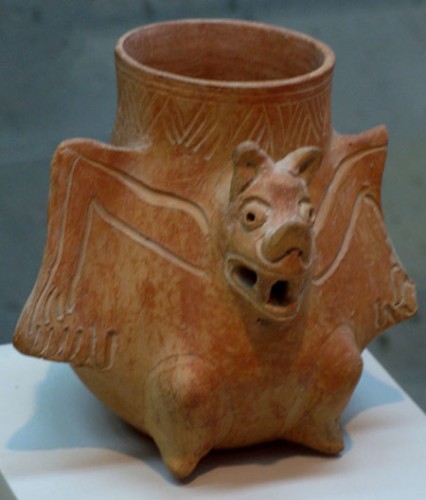
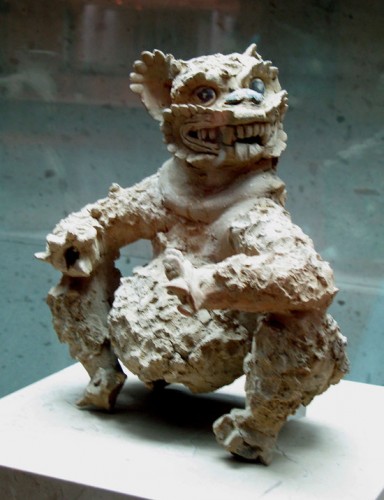
Migration nation
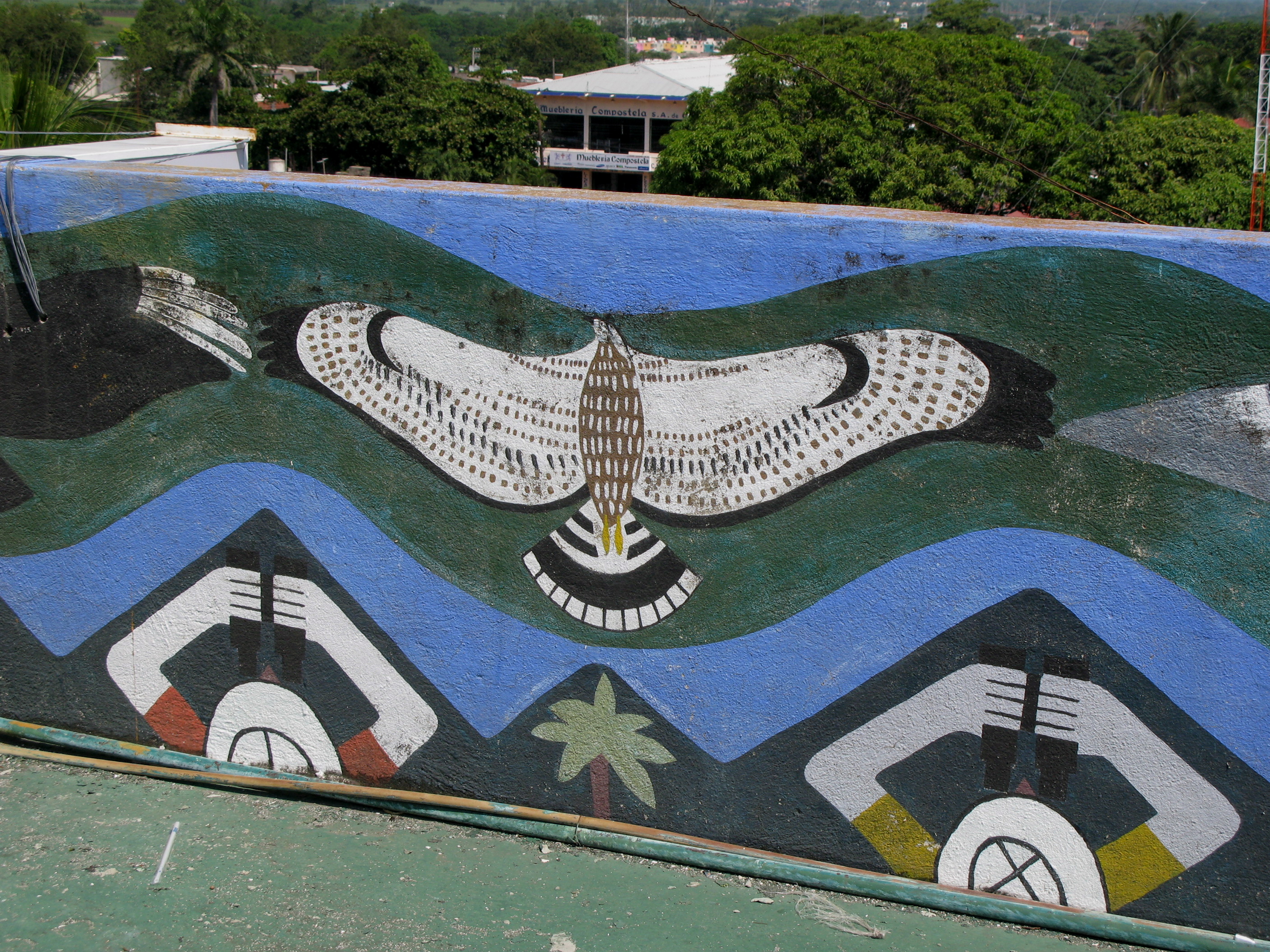
 There is a gap in Three Star Owl postings between Cranky Owlet hears autumn and the Canyon Wren post. This is because for nearly two weeks I was in Mexico, looking at birds. Though the trip had long been planned and paid for, it was a strange thing to be doing while the US economy was falling apart. I was out of the country during the initial flap while the bailout was being tussled over, while the market was first plunging, while the vice presidential candidates were debating. These serious events made looking for birds seem both frivolous and fundamental simultaneously. Frivolous because spending money on vacation travel in a time of economic uncertainty seems unwise and even trivial. Fundamental because, well, the birds were still living their lives, existing in their environments as usual, evading predators, searching for food, migrating thousands of miles to distant wintering grounds, and observing this was a connection to an elemental reality.
There is a gap in Three Star Owl postings between Cranky Owlet hears autumn and the Canyon Wren post. This is because for nearly two weeks I was in Mexico, looking at birds. Though the trip had long been planned and paid for, it was a strange thing to be doing while the US economy was falling apart. I was out of the country during the initial flap while the bailout was being tussled over, while the market was first plunging, while the vice presidential candidates were debating. These serious events made looking for birds seem both frivolous and fundamental simultaneously. Frivolous because spending money on vacation travel in a time of economic uncertainty seems unwise and even trivial. Fundamental because, well, the birds were still living their lives, existing in their environments as usual, evading predators, searching for food, migrating thousands of miles to distant wintering grounds, and observing this was a connection to an elemental reality.
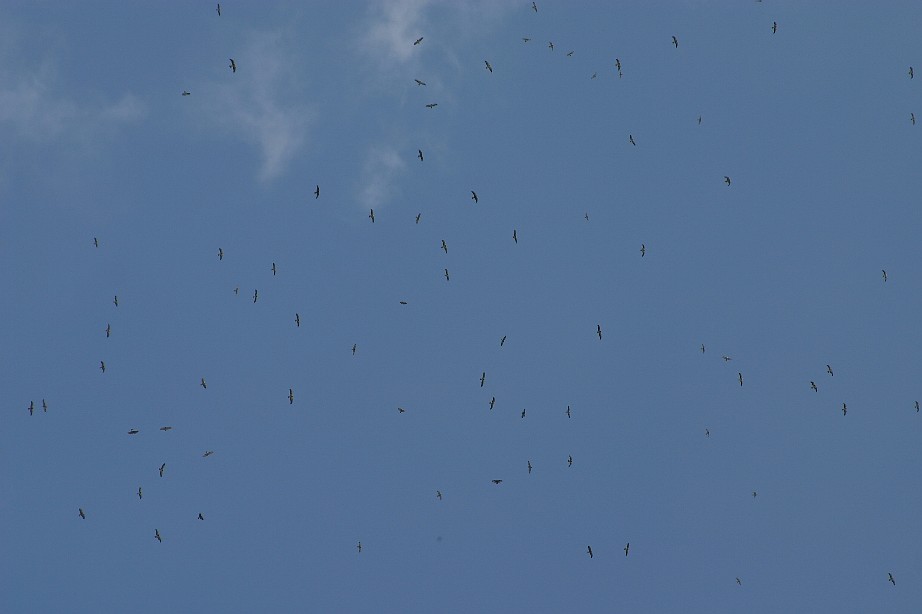 The group I was with was traveling in the Mexican state of Veracruz to see, among other things, the spectacular flights of north American birds of prey funneled along the Gulf Coast of Mexico, the famous so-called Rio de Rapaces. Osprey, Turkey vultures, Broad-winged hawks, Swainson’s hawks, Mississippi kites, Peregrine falcons, Merlins, and others, as well as non-raptors such as American white pelicans, Scissor-tailed flycatchers, Wood storks, and Anhingas swirl overhead in dynamic kettles, spiraling upward on thermals, rising like litter in a dust-devil until they are high enough to stream outward in a south-bound line, some to Central America, others like the Swainson’s hawk, all the way to central South America. Below, their vast exodus is mirrored by the southward movement of songbirds, some nearly at ground level: warblers, thrushes, shorebirds, flycatchers, dickcissels, vireos, grosbeaks, and other songbirds, heading southward mostly at night, stopping to rest and feed during the day in the resource-rich coastal plains, transitional foothills, and tropical forests of the moist state of Veracruz.
The group I was with was traveling in the Mexican state of Veracruz to see, among other things, the spectacular flights of north American birds of prey funneled along the Gulf Coast of Mexico, the famous so-called Rio de Rapaces. Osprey, Turkey vultures, Broad-winged hawks, Swainson’s hawks, Mississippi kites, Peregrine falcons, Merlins, and others, as well as non-raptors such as American white pelicans, Scissor-tailed flycatchers, Wood storks, and Anhingas swirl overhead in dynamic kettles, spiraling upward on thermals, rising like litter in a dust-devil until they are high enough to stream outward in a south-bound line, some to Central America, others like the Swainson’s hawk, all the way to central South America. Below, their vast exodus is mirrored by the southward movement of songbirds, some nearly at ground level: warblers, thrushes, shorebirds, flycatchers, dickcissels, vireos, grosbeaks, and other songbirds, heading southward mostly at night, stopping to rest and feed during the day in the resource-rich coastal plains, transitional foothills, and tropical forests of the moist state of Veracruz.
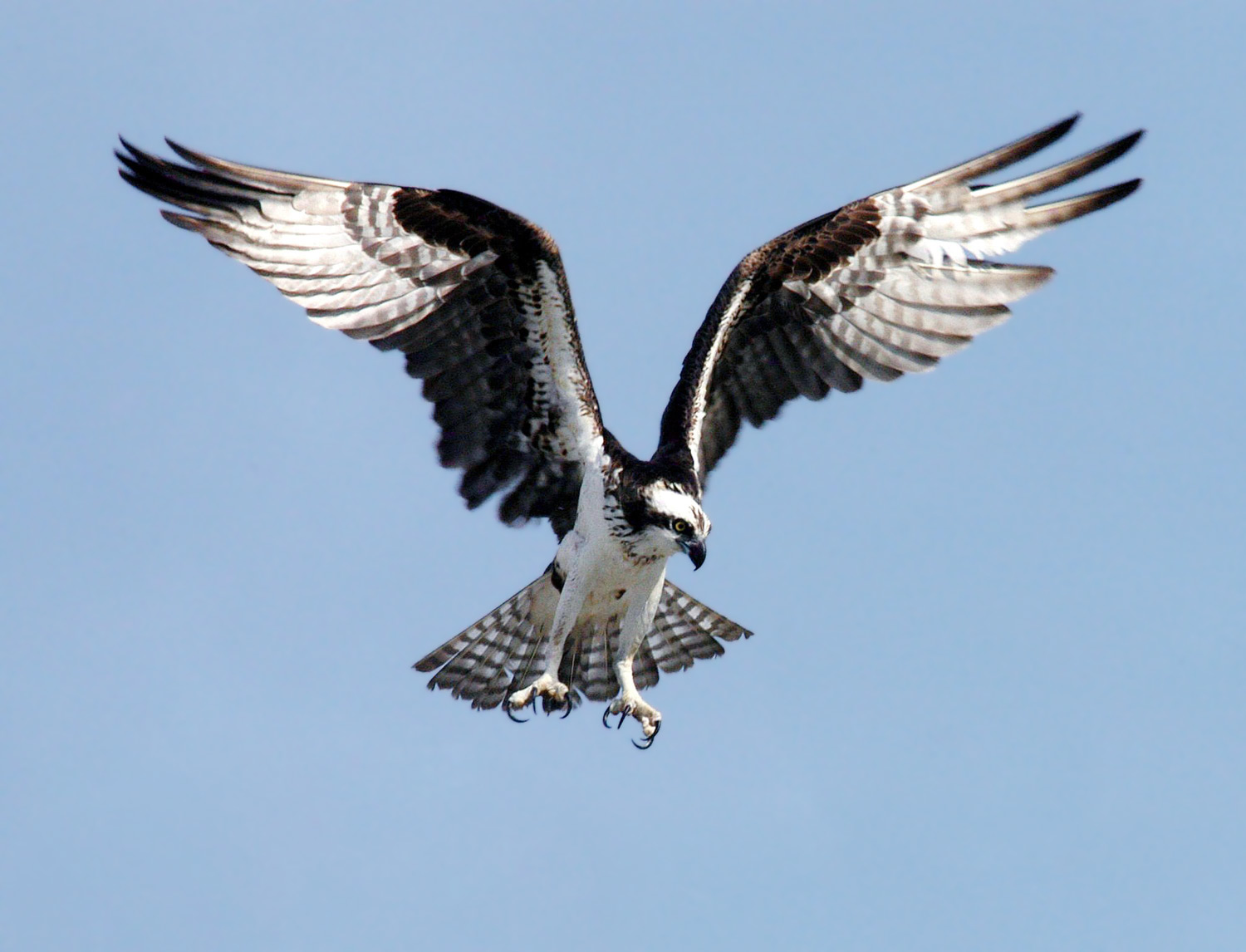 These are birds that we are accustomed to thinking of, imprecisely, as “ours”. They are ours, in a sense, because they breed in various parts of the United States and Canada. But for more than half the year, they live in regions closer to the equator, Mexico, Central, and South America, which countries have at least as great a “claim” to the birds as “we” do. They belong to both northern and southern America: this is a hemispheric, in some cases even global, avian economy, in which birds go when and where there is a living to be made, whether the seasonal draw is fruit, seeds, insects, other birds to eat, or survivable temperatures.
These are birds that we are accustomed to thinking of, imprecisely, as “ours”. They are ours, in a sense, because they breed in various parts of the United States and Canada. But for more than half the year, they live in regions closer to the equator, Mexico, Central, and South America, which countries have at least as great a “claim” to the birds as “we” do. They belong to both northern and southern America: this is a hemispheric, in some cases even global, avian economy, in which birds go when and where there is a living to be made, whether the seasonal draw is fruit, seeds, insects, other birds to eat, or survivable temperatures.
At that time, watching CNN in English on a hotel lobby TV hearing US announcers and US politicians expound, it was easy to think of all the economic turbulence as a US problem, with the rest of the world watching from a distance. That was until the the day before we left, when the peso, after a decade of stability at 10 to the American dollar, fell nearly 40 per cent in one day, largely because of the drop in the price of oil. Suddenly, like the movement of birds across the Americas, everything seemed closely related after all.
For the Pronatura Veracruz October 2008 actual day-by-day count of raptors seen, click here.
For an excellent read on the astounding fact and feat of avian migration, try Scott Weidensaul’s “Living on the Wind: across the hemisphere with migratory birds”. He’ll make you realize that migration is an even more amazing phenomenon than it seems. Chapter 5, Rivers of Hawks, is specifically on the Veracruz migration and its fairly recent discovery. As for learning about global economics, you’re on your own. I think we all need to start from scratch, at this point.
Photos: Top, (A. Shock), mural of a Broadwinged hawk and birdcensuser motif on the parapet wall of the Pronatura Hawkwatch site on the roof of the Hotel Bienvenidos, Cardel, Veracruz. Center: kettle of raptors, photo pinched from the site of the North American Ornithological Conference 2006, because I couldn’t get my camera to focus on all those little specks. Below: Osprey from National Park Service Padre Island website.
Isabelline California towhee in Huntington Beach Central Park
On Sunday, Aug 31 2008, while birding in the middle of the Civil War (or at least a re-enactment of it), I saw a sandy-beige bird feeding on the lawn at the edge of a brushy area in Huntington Beach Central Park. It was consorting with two typically-plumaged California towhees, and it appeared to be identical to them in everything but color. The entire bird was buffy, including flight and tail feathers, with no darker brown “towhee-colored” feathers on it, and was paler on the breast and underside. Its bill was pinkish-gray. I got good looks at the bird, with and without binoculars before it flew up into a small tree about 25 feet away, where it perched for a minute, making a sharp chip note that was towhee-like. Though it was partially concealed in the branches, it was possible to get a couple of digital images.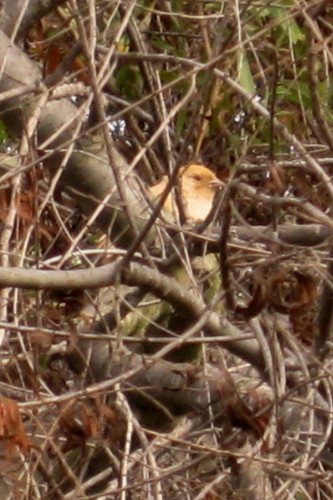 This is the best one, slightly cropped to make the bird larger in the frame. I believe it is an Isabelline California towhee.
This is the best one, slightly cropped to make the bird larger in the frame. I believe it is an Isabelline California towhee.
Perhaps this aberrant-plumaged individual is well-known to local birders (I’m from out-of-state); it certainly stood out against the green lawn, and was very much brighter in tone than the other typical, subdued California towhees it was with.
Other than an absurd number of Orange-crowned warblers and the previously mentioned Civil War encampment, it was the only notable sighting of the morning. The Audubon group (LA?) we met leaving as we came in were off to Bolsa Chica because nothing much was up in the Park, perhaps because of the cannon and rifle-fire?
As a born Californian, I will refrain from making any blond remarks and simply wish the bird success in evading accipiters, feral cats, and black-powder firearms.
Incidentally, here is an explantaion for the color term “Isabelline” meaning dun or dirty beige: “The name of Isabelline, this grayish-yellow colour comes from the colour of the underwear of Isabel Clara Eugenia, daughter of King Philip II of Spain who at the siege of Ostend vowed not to change her underwear until the city was captured. The siege lasted for three years so the colour of her underwear must have been truly grayish-yellow (isabelline) when the city was finally taken.” I cannot confirm accuracy, only cite internet source.
Accidental residents: reddish egrets and green sea turtles
I’ve just returned from a visit to the parental home in coastal Orange County California, where my mother still lives. The house is walking distance from the beach — all during the Labor Day weekend, we could smell the beach fires and hear the engines of small planes dragging ad banners low along the coast.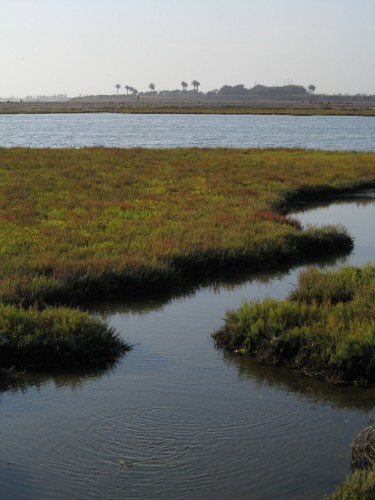
 When I was a kid, the beach was where we went to “lay out” or body surf. Now, I’m more likely to head to the Bolsa Chica Ecological Preserve, also within a short walk, to look at birds. One of the last remaining wetlands in southern California, Bolsa Chica has been a battle ground for decades between developers, politicians, environmentalists, and citizens.
When I was a kid, the beach was where we went to “lay out” or body surf. Now, I’m more likely to head to the Bolsa Chica Ecological Preserve, also within a short walk, to look at birds. One of the last remaining wetlands in southern California, Bolsa Chica has been a battle ground for decades between developers, politicians, environmentalists, and citizens.
Though its current state is more stable than it was, it’s hard to believe the struggle is over, since the Preserve is still being hemmed in by huge showy homes looking down onto it from the bluffs on one side and clanking, chugging oil rigs on the other. But in between is a haven well-known to birds and birders, as well as families and walkers with (forbidden) dogs. The Preserve is in a constant state of change, not only from natural phenomena like tides and the weather, but also man-made: fairly recently a channel was constructed to open the water of the Preserve to the sea — a re-engineering of its natural daily access to fresh ocean water, instead of a sluggish exchange of greasy harbor water that worked its way through local marina channels. 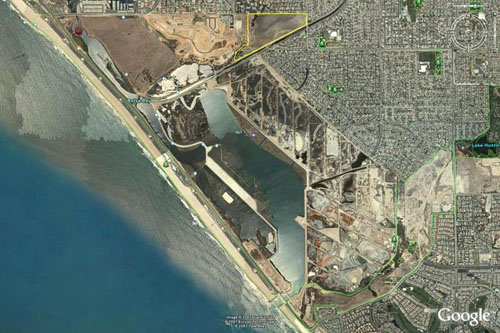 Observers are still evaluating the effects of this. But the terns and Black skimmers still nest on the sandy island, endangered snowy plovers have nesting areas safe from foot traffic and vehicles, and the endangered Belding’s race of the Savannah
Observers are still evaluating the effects of this. But the terns and Black skimmers still nest on the sandy island, endangered snowy plovers have nesting areas safe from foot traffic and vehicles, and the endangered Belding’s race of the Savannah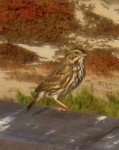 sparrow is sometimes ridiculously easy to see in the pickleweed. Small numbers of Least terns, also endangered, are harder to pick out from among the clouds of larger, skrekking Caspian, Elegant and Forster’s terns. Winter will bring ducks and grebes, and now in late summer, the shorebirds are returning, some, like a few of the dowitchers, still sporting shreds of buffy breeding plumage fresh from their arctic breeding grounds.
sparrow is sometimes ridiculously easy to see in the pickleweed. Small numbers of Least terns, also endangered, are harder to pick out from among the clouds of larger, skrekking Caspian, Elegant and Forster’s terns. Winter will bring ducks and grebes, and now in late summer, the shorebirds are returning, some, like a few of the dowitchers, still sporting shreds of buffy breeding plumage fresh from their arctic breeding grounds.
As havens often do, Bolsa Chica has attracted unexpected residents. For a couple of years now, birders have been watching a small number of Reddish egrets in the tidal flats — two that I know of — a species that is normally found in warmer regions. On the Bolsa Chica Conservancy‘s online bird list, the Reddish egrets rate only an “X” for “accidental”. They seem to know exactly what they’re doing, however, with their active 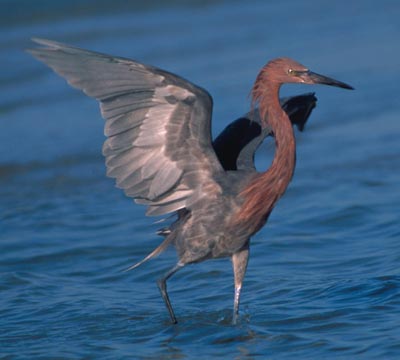 foraging dance in which they dart and hop, holding their wings above their head, snaking their long necks forward to snatch at small fish and invertebrates from the water at their feet. You’d expect to see these guys in Louisiana, or Mexico. But here they are doing what they do like they belong here, being spied upon by scopes and long lenses, among the resident Snowy and Great egrets and Great blue herons. Like immigrants everywhere, they are sometimes subject to competitive pecks and unwelcoming charges by the locals, in the form of irritable Great Blues whose personal space is compromised.
foraging dance in which they dart and hop, holding their wings above their head, snaking their long necks forward to snatch at small fish and invertebrates from the water at their feet. You’d expect to see these guys in Louisiana, or Mexico. But here they are doing what they do like they belong here, being spied upon by scopes and long lenses, among the resident Snowy and Great egrets and Great blue herons. Like immigrants everywhere, they are sometimes subject to competitive pecks and unwelcoming charges by the locals, in the form of irritable Great Blues whose personal space is compromised.
All of Southern California has a reputation for harboring incomers from other places. The Reddish egrets are only one example. Another, new to me as a non-resident, but apparently known to local fishermen and living here for a while, are Green Sea Turtles. A news story over the Labor Day weekend was the first I’ve heard of this: a Green sea turtle was rescued from where it was trapped in a dishcarge channel in the Haynes Generating Station on the grubby and channelized San Gabriel River. Check out the excellent LA Times article for the full fascinating story, but apparently there is a handful of these big turtles living at least part of their lives in the warm waters a short distance upstream 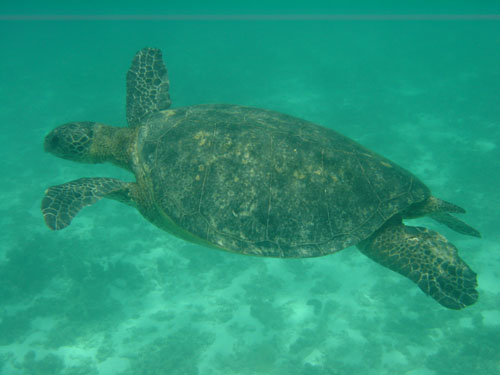 from where the San Gabriel empties into the Pacific at the border of LA and Orange Counties. Even more remarkable is that there is a large colony of these animals living in San Diego. This group numbers at least a hundred and, according to researchers, is headed up by a 570-pound matriarch they call “Wrinklebutt.” The theory is that the San Gabriel River turtle group is an outpost of Wrinklebutt’s colony. It makes them the northernmost known foraging population of Green Sea turtles in North America.
from where the San Gabriel empties into the Pacific at the border of LA and Orange Counties. Even more remarkable is that there is a large colony of these animals living in San Diego. This group numbers at least a hundred and, according to researchers, is headed up by a 570-pound matriarch they call “Wrinklebutt.” The theory is that the San Gabriel River turtle group is an outpost of Wrinklebutt’s colony. It makes them the northernmost known foraging population of Green Sea turtles in North America.
This coastal visit is well-timed for me artistically, bringing an influx of fresh ocean species, just at a time when I’m beginning work on pieces for the San Diego Bird Festival next March. So soon skimmers and terns and sea turtles will be migrating into Three Star Owl imagery, joining the desert species dwelling there already. And, maybe when I’m in San Diego, I’ll try to see Wrinklebutt and her cohorts.
Poor Old Papago Park
One of my simple pleasures is going on early morning walks with E around the buttes in Papago Park. We can walk there from our house, and though the walks are for health, we always make note of birds and the other animals we see.
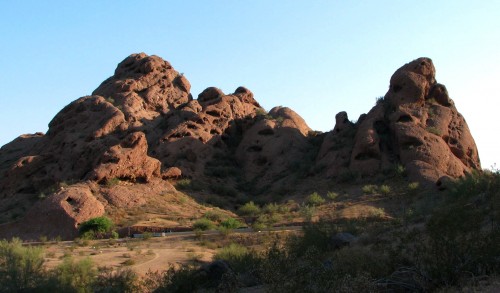
A first impression of this landscape is accurate: a worn scrap of urban desert, surrounded by buildings and golf courses. (At 1200 acres, this scrap seems to be getting smaller all the time, as the City of Phoenix doesn’t seem to be able to keep its hands to itself: even this morning we noticed a shiny chain link fence slashed across the creosote flats, closer to the butte trail than just a few days ago; a golf-course expansion, I suppose, because Phoenix doesn’t have enough acres in fairways?) I don’t have a biologist’s expertise, but the buttes and the land between them don’t seem to be a rich or terribly diverse environment. Next to the lush Zoo and wonderful Desert Botanical Garden, where the birding is always great, the part of Papago west of the parkway seems especially barren. Sometimes we only see a handful of bird species, and no mammals but other humans and their dogs (and only a few of those in our early hours). But over the years and through all seasons in all weather, we’ve discovered that there’s more in Poor Old Papago than you might expect.
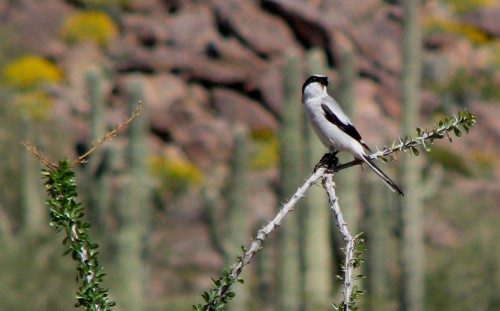 This morning’s walk was a perfect example. In addition to the numerous mourning doves and house finches, there were two Loggerhead shrikes in the park, fierce “functional raptors” looking for a protein-rich breakfast like a grasshopper or small lizard. They were making their ratchety “shrike-shrike” call from the tops of the greened-up creosotes, so we heard them before we saw them, though once we got closer the shrikes’ bold gray, black and white plumage blinked in the sun. The verdins saw the shrikes too, emitting incessant alarm calls and flicking their wings.
This morning’s walk was a perfect example. In addition to the numerous mourning doves and house finches, there were two Loggerhead shrikes in the park, fierce “functional raptors” looking for a protein-rich breakfast like a grasshopper or small lizard. They were making their ratchety “shrike-shrike” call from the tops of the greened-up creosotes, so we heard them before we saw them, though once we got closer the shrikes’ bold gray, black and white plumage blinked in the sun. The verdins saw the shrikes too, emitting incessant alarm calls and flicking their wings.
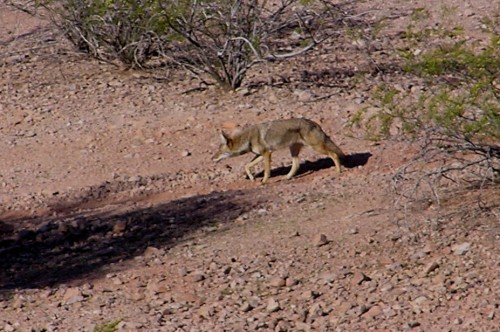 The serious, top-order predators were out, too: a Red-tailed hawk launched itself with a cry off the rock we call “Jaws” and flew south to the biggest butte, Barnes Butte (named after Will C. Barnes who is known himself for writing a book on Arizona place names). And the ‘yotes were out: Coyotes are pretty common in the park. This morning we saw two together, an apparent family: an adult and young one, looking a bit scruffy, like the park itself. We’ve seen coyotes actually stalk dog-walkers, maybe keeping an eye on things until the other four-legs are off their patch of land. When fire engines hurtle by, the Butte “goes off” and invisible ‘yotes howl and yip until the sirens are faint.
The serious, top-order predators were out, too: a Red-tailed hawk launched itself with a cry off the rock we call “Jaws” and flew south to the biggest butte, Barnes Butte (named after Will C. Barnes who is known himself for writing a book on Arizona place names). And the ‘yotes were out: Coyotes are pretty common in the park. This morning we saw two together, an apparent family: an adult and young one, looking a bit scruffy, like the park itself. We’ve seen coyotes actually stalk dog-walkers, maybe keeping an eye on things until the other four-legs are off their patch of land. When fire engines hurtle by, the Butte “goes off” and invisible ‘yotes howl and yip until the sirens are faint.
There’s plenty for the coyotes to eat, actually, if they can catch it. Stray cats, for instance. (When we first started walking in the park, one of our landmarks was “Half-cat Stash” — a bit of feline jerky with clumped, sun-bleached pelt patches that was gradually being reduced by some not very picky predator) Also, there are 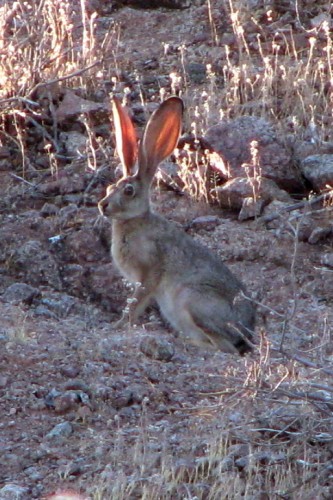 Black-tailed jackrabbits. We’ve seen as many as eleven during one walk, their radiator-ears glowing pink with the low sun shining through them. Desert cotton-tails are common, too. These tough lagomorphs are numerous enough in the park so that the City has had to chicken-wire the young saguaros to keep them from being girdled by gnawing teeth. The cactus situation is at best marginal in the park: there are few new ones coming up, and some of the old saguaros are dying: one we called the “Condo” because it hosted numerous starlings and a Gila woodpecker or two just recently came down in a monsoon windstorm. Now it’s lying there rotting, gradually watering its nurse tree. Hard to believe this land was designated Papago Saguaro National Monument from 1914 until 1930, known for the stately columnar cactus. But now, Papago definitely calls out for some succulent guerilla gardening…
Black-tailed jackrabbits. We’ve seen as many as eleven during one walk, their radiator-ears glowing pink with the low sun shining through them. Desert cotton-tails are common, too. These tough lagomorphs are numerous enough in the park so that the City has had to chicken-wire the young saguaros to keep them from being girdled by gnawing teeth. The cactus situation is at best marginal in the park: there are few new ones coming up, and some of the old saguaros are dying: one we called the “Condo” because it hosted numerous starlings and a Gila woodpecker or two just recently came down in a monsoon windstorm. Now it’s lying there rotting, gradually watering its nurse tree. Hard to believe this land was designated Papago Saguaro National Monument from 1914 until 1930, known for the stately columnar cactus. But now, Papago definitely calls out for some succulent guerilla gardening…
Even after all the walks we’ve taken In Papago Park, E and I are still seeing things for the first time, like the barrel cactus we found this summer only because the monsoon has been better than usual. Normally invisible against the gravelly soil the heads of several barrels blazed out in the washes because rain had soaked them over night and their normally dry, brown spines had taken on their true color: bright red. We know where one hedgehog cactus grows, having seen it only because it was in full bloom. There are even pincushion cactus, Mammillaria grahamii (or “mammo-grahams” as we’ve nicknamed them, Graham’s nipple cactus) tucked away on a sunny slope of the little butte. One day we hope to catch them blooming, too. Even more invisible was a Lesser nighthawk on her nest,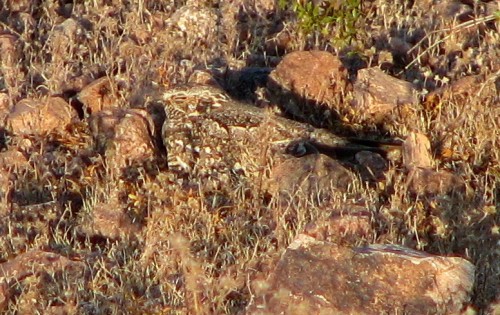 staunchly incubating through the monsoon season, hidden in plain sight under a small creosote. We don’t know for sure if she successfully fledged her young, but we’d like to think so. Can you find her invisibly sitting tight on her nest in the photo above (Spot the Bird)?
staunchly incubating through the monsoon season, hidden in plain sight under a small creosote. We don’t know for sure if she successfully fledged her young, but we’d like to think so. Can you find her invisibly sitting tight on her nest in the photo above (Spot the Bird)?
There are always surprises: last fall a gleaming, swift Prairie falcon lingered in the high rocks and air overhead; we watched it for two weeks before it moved on. Also, what was left of a Barn owl, abandoned on the top of a rock after it had become a meal for a Great horned owl (they’re there although we’ve never seen one — occasionally there’s a softly barred feather caught fluttering in a shrub). There are strangers, too: an exotic male zebra finch hung out with a 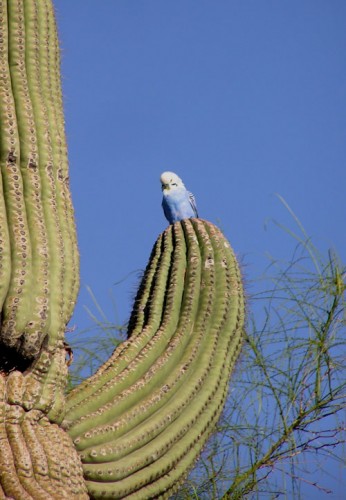 flock of native house finches for a week or so; and nearby there’s a thriving breeding population of Budgies (parakeets) nesting in saguaro cavities.
flock of native house finches for a week or so; and nearby there’s a thriving breeding population of Budgies (parakeets) nesting in saguaro cavities.
Lodged in the cracks between Phoenix, Tempe, and Scottsdale, Papago Park may not seem a terribly wild place, but it is something very precious in the middle of the metropolitan area: open desert space in an area that’s been the residential heart of the Rio Salado settlement for thousands of years.
Poor Old Papago Park. There’s been talk of “improvement” for Papago for years. Does it need improvement? In my view “Improvement” doesn’t always include parking lots, pavement or pathways. Because the beauties and benefits of Papago are subtle and in their natural state, I fear they will be overlooked by ambitious city managers, profit-seeking developers and even well-meaning citizens eager to “improve” something that doesn’t need improvement, but rather a little appreciation for what it is.
All photos©threestarowl.com. All photos in this post taken by E. Shock in Papago Park, except the Loggerhead shrike, taken on the Margie’s Cove trail in the Maricopa Mountains.

